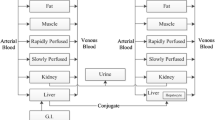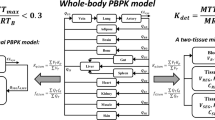Abstract
In modern pharmacokinetic analysis, the urinary bladder is usually viewed as a nonreturning compartment or storage site for renally excreted compounds. Our previous studies have indicated appreciable bladder resorption of drugs. The present study used computer simulations to evaluate the quantitative importance of several potential determinants of bladder resorption, namely the bladder resorption rate constant (k a), interval between bladder voiding (Δt void),ratio of renal elimination rate constant to overall elimination rate constant (k ex:k el ratio), andk el ort 1/2. The data identifiedk a, Δt void, andk ex:k el ratio as the three most important determinants of the rate and extent of bladder resorption. We further examined the errors introduced in the derived pharmacokinetic parameters due to omission of bladder resorption. Plasma concentration-time profiles and urinary excretion-time profiles were generated by simulations using different values ofk a, Δt void, andk ex:k el ratio. These profiles were used to derive the pharmacokinetic parameters, including the renal clearance (CL renal), total body clearance (CL total), nonrenal clearance (CL nonrenal),t 1/2, mean residence time (MRT), amount and fraction of dose excreted in urine (A ex andf e), and volume of distribution at steady state (Vd ss). Data show that resorption of drug from the bladder into the systemic circulation increased the area under the plama concentration-time profile,MRT andt 1/2, but decreasedCL renal,CL total,A ex, andf e.Vd ss was relatively unchanged. Overestimation of MRT andt 1/2 was dependent onk a,k ex:k el ratio,and Δt void. Underestimation inCL renal,A ex, andf e was not dependent on thek ex:k el ratio, but was affected by changes ink a and Δt void.CL renal andf e were the most sensitive pharmacokinetic parameters, with a≥50% underestimation at ak a value that we reported previously, for the bladder absorption of antipyrine in rats with intact urothelium. In summary, these data indicate (i) alteration in the plasma concentration-time profiles and urinary excretion-time profiles due to bladder resorption, and (ii) substantial over-or underestimation in the derived pharmacokinetic parameters due to erroneous omission of bladder resorption.
Similar content being viewed by others
Abbreviations
- A ex :
-
Cumulative amount of drug excreted in urine
- CL total :
-
Total body clearance
- CL renal :
-
Renal clearance
- CL nonrenal :
-
Nonrenal clearance
- f c :
-
Fraction of unchanged drug excreted in urine
- k a :
-
Bladder resorption rate constant
- k ex :
-
Renal excretion rate constant
- k nr :
-
Nonrenal elimination rate constant
- k el :
-
Overall elimination rate constant
- t 1/2 :
-
Half-life
- Vd ss :
-
Volume of distribution at steady state
- AUC :
-
Area under the plasma concentration-time profile
- MRT :
-
Mean residence time
- Δt void :
-
Time interval between urinary voids
- AUMC :
-
Area under the (concentration x time) vs. time profile
References
J. F. Borzelleca. Studies on the mechanisms of drug movement from the isolated urinary bladder.J. Pharmacol. Exp. Ther. 148:111–116 (1965).
J. F. Borzelleca and W. Lowenthal. A kinetic analysis of drug movement from the isolated urinary bladder of the rabbit.Arch. Int. Pharmacodyn. 166:26–35 (1967).
J. D. Conklin and R. D. Hollifield. Studies on the movement of nitrofurantoin across the dog urinary bladder.Invest. Urol. 5:244–249(1967).
A. G. Renwick and T. W. Sweatman. The absorption of saccharin from the rat urinary bladder.J. Pharm. Pharmacol. 31:650–652 (1979).
J. L.-S. Au, J. T. Dalton, and M. G. Wientjes. Evidence of significant absorption of sodium salicylate from urinary bladder of rats.J. Pharmacol. Exp. Ther. 258:357–364 (1991).
J. T. Dalton, M. D. Harrington, and J. L.-S. Au. Evidence of significant absorption of antipyrine from urinary bladder of rats.J. Pharmacol. Exp. Ther. 260:608–613 (1992).
G. Lunglmayr and K. Czech. Absorption studies on intraluminal thiotepa for topical cytostatic treatment for low-stage bladder tumors.J. Urol. 106:72–74 (1971).
M. Pavone-Macaluso, N. Gebbia, F. Biondo, S. Bertolini, G. Caramia, and F. P. Rizzo. Permeability of the bladder mucosa to thiotepa, adriamycin, and daunomycin in men and rabbits.Urol. Res. 4:9 (1976).
J. T. Dalton, M. G. Wientjes, R. A. Badalament, J. R. Drago, and J. L.-S. Au. Pharmacokinetics of intravesical mitomycin C in superficial bladder cancer patients.Cancer Res. 51:5144–5152 (1991).
F. F. Kadlubar, K. L. Dooley, C. H. Teitel, D. W. Roberts, R. W. Benson, M. A. Butler, J. R. Bailey, J. F. Young, P. W. Skipper, and S. R. Tannenbaum. Frequency of urination and its effects on metabolism, pharmacokinetics, blood hemoglobin adduct formation, and liver and urinary bladder DNA adduct levels in beagle dogs given the carcinogen 4-aminobiphenyl.Cancer Res. 51:4371–4377 (1991).
J. F. Young and F. F. Kadlubar. A pharmacokinetic model to predict exposure of the bladder epithelium to urinary N-hydroxyarylamine carcinogens as a function of urinary pH, voiding interval, and resorption.Drug. Metab. Rev. 10:641–644 (1982).
J. H. Wood and T. W. Leonard. Kinetic implications of drug resorption from the bladder.Drug. Metab. Rev. 14:407–423 (1983).
A. Finkbeiner and J. Lapides. Effect of distention on blood flow in dog's urinary bladder.Invest. Urol. 12:210–212 (1974).
M. G. Wientjes, J. T. Dalton, R. A. Badalament, J. R. Drago, and J. L.-S. Au. Bladder wall penetration of intravesical mitomycin C in dogs.Cancer Res. 51:4347–4354 (1991).
M. Rowland and T. N. Tozer.Clinical Pharmacokinetics: Concepts and Applications, 2nd ed., Lea and Febiger, Philadelphia, PA, 1989.
M. A. H. Russell and C. Feyerabend. Cigarette smoking: A dependence on high-nicotine boli.Drug Metab. Rev. 8:29–57 (1978).
R. A. Upton, J. N. Buskin, R. L. Williams, N. H. G. Holford, and S. Riegelman. Negligible excretion of unchanged ketoprofen, naproxen, and probenecid in urine.J. Pharm. Sci. 69:1254–1257 (1980).
M. Bonati, R. Latini, G. Tognoni, J. F. Young, and S. Garattini. Interspecies comparison ofin vivo caffeine pharmacokinetics in man, monkey, rabbit, rat, and mouse.Drug Metab. Rev. 15:1355–1383 (1985).
E. T. Gonzales and J. F. Glenn. Experimental estimation of transvesical digoxin absorption.Invest. Urol. 9:238–240 (1971).
J. M. Mayer, S. D. Hall, and M. Rowland. Relationship between lipophilicity and tubular reabsorption for a series of 5-alkyl-5-ethylbarbituric acids in the isolated perfused rat kidney preparation.J. Pharm. Sci. 77:359–364 (1988).
W. Weber, M. Nitz, and M. Looby. Nonlinear kinetics of the thiamine cation in humans: saturation of nonrenal clearance and tubular reabsorption.J. Pharmacokin. Biopharm. 18:501–523 (1990).
G. Levy and R. Koysooko. Renal clearance of theophylline in man.J. Clin. Pharmacol. 16:329–332 (1976).
D. D.-S. Tang-Liu, T. N. Tozer, and S. Riegelman. Urine flow dependence of theophylline renal clearance in man.J. Pharmacokin. Biopharm. 10:351–364 (1982).
R. M. Hicks, B. Ketterer, and R. C. Warren. The ultrastructure and chemistry of the luminal plasma membrane of the mammalian urinary bladder: A structure with low permeability to water and ions.Phil. Trans. Roy. Soc. London B. 268:23 (1974).
Author information
Authors and Affiliations
Additional information
Supported in part by MERIT grant R37 CA-49816, and Research Career Development Award K04 CA-01497 for J. L-S. Au, from The National Cancer Institute, National Institutes of Health, Department of Health and Human Services.
Rights and permissions
About this article
Cite this article
Dalton, J.T., Wientjes, M.G. & Au, J.LS. Effects of bladder resorption on pharmacokinetic data analysis. Journal of Pharmacokinetics and Biopharmaceutics 22, 183–205 (1994). https://doi.org/10.1007/BF02353328
Received:
Accepted:
Published:
Issue Date:
DOI: https://doi.org/10.1007/BF02353328




